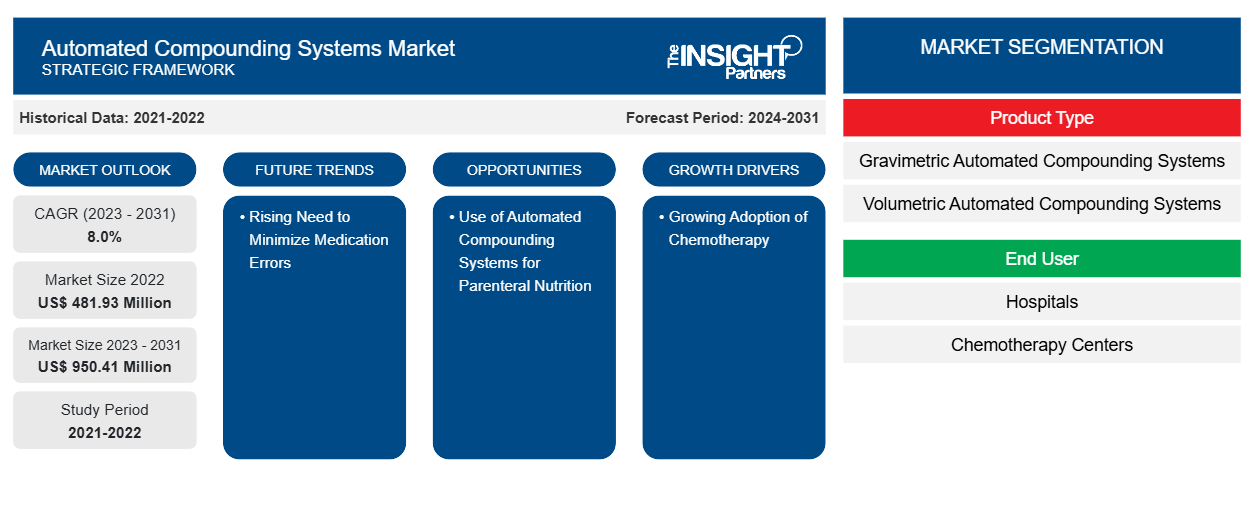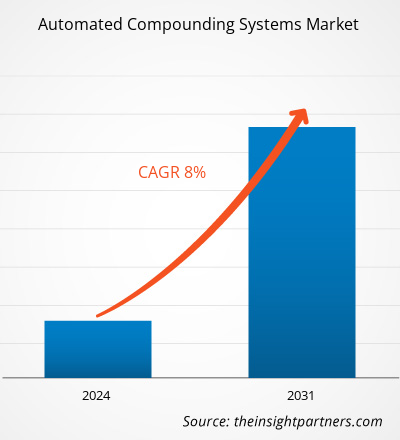The Automated Compounding Systems Market size was estimated to be US$ 481.93 million in 2022 and US$ XX million in 2023 and is expected to reach US$ 950.41 million by 2031; it is estimated to record a CAGR of 8.0% till 2031. Strategic developments and product launches are likely to remain key Automated Compounding Systems Market trends.
Automated Compounding Systems Market Analysis
Increasing demand for personalized medicines, improved patient safety, stringent regulations for medication compounding, efficiency and cost effectiveness of automated compounding systems, and increasing awareness in pharmacists is driving the growth of the automated compounding systems market. In addition, increase in prevalence of chronic diseases has fueled the demand for automated compounding systems.
Automated Compounding Systems Market Overview
Automated compounding system helps avoid medication error that occurs due to variety of factors such as poor management communication between the physician and pharmacist, critical storage practices in pharmacies, and confusion that was arising out of the use of similar labels. Moreover, with the automated compounding systems, the accuracy as well as efficiency of dispensing compounded products have improved, and it has further reduced the exposure of healthcare professionals to toxic agents.
Customize This Report To Suit Your Requirement
You will get customization on any report - free of charge - including parts of this report, or country-level analysis, Excel Data pack, as well as avail great offers and discounts for start-ups & universities
Automated Compounding Systems Market: Strategic Insights

-
Get Top Key Market Trends of this report.This FREE sample will include data analysis, ranging from market trends to estimates and forecasts.
Automated Compounding Systems Market Drivers and Opportunities
Rising Need to Minimize Medication Errors
Medication and dispensing errors are the major issues for hospital readmissions across the world. Medication errors can happen by both medical and paramedical personnel at numerous levels of patient care. A medication error can happen due to several factors such as poor order communication between the doctor and pharmacist, hazardous storage practices in drugstores, and misunderstanding raised due to the usage of the same labels. Hence, multilevel monitoring is compulsory. Automated compounding systems are deliberated to be one of the most qualified solutions to diminish these errors. Various government organizations are working on the measures to avoid medication errors and developing methods and systems to overcome these errors in order to provide proper medication to the patients. Thus, to minimize medication and compounding errors, governments in several nations are encouraging the use of automated compounding and medication tools in pharmacies and hospitals. This is considered to be a major factor propelling the growth of automated compounding systems market.
Use of Automated Compounding Systems for Parenteral Nutrition – An Opportunity of Automated Compounding Systems Market
Parenteral nutrition is indicated when patients cannot meet their nutritional needs due to diseases, such as cancer and chronic diseases affecting the gastrointestinal tract. This type of nutrition is the cornerstone of therapy for most patients with severe short bowel syndrome (SBS). SBS occurs in ~3 per 1 million people yearly. As per the article titled “Understanding Short Bowel Syndrome: Current Status and Future Perspectives," published in 2020, the prevalence of SBS has increased by more than twofold in the last 40 years. The prevalence was ~30 cases per million in the US and approximately 1.4 cases per million in Europe. Automated compounding systems can be used to manufacture parenteral nutrition products. The automated compounding systems is usually linked to dedicated software that electronically transfers information about PN formulations. A number of researchers are comparing the PN formulations prepared by automated compounding systems and by manual methods. The ongoing researches for use of automated compounding systems for formulation of PN is expected to create opportunity for growth of automated compounding systems market.
Automated Compounding Systems Market Report Segmentation Analysis
Key segments that contributed to the derivation of the Automated Compounding Systems Market analysis are route of administration, application, and end user.
- Based on product type, the Automated Compounding Systems Market is segmented into gravimetric automated compounding systems, and volumetric automated compounding systems. The gravimetric automated compounding systems segment held the largest market share in 2023.
- By end user, the Automated Compounding Systems Market is segmented into hospitals, chemotherapy centers, and others. The hospitals segment held the largest market share in 2023.
Automated Compounding Systems Market Share Analysis by Geography
The geographic scope of the Automated Compounding Systems Market report is mainly divided into five regions: North America, Asia Pacific, Europe, Middle East & Africa, and South & Central America.
North America has dominated the Automated Compounding Systems Market. The market growth in North America is characterized by increased demand for chronic disease medications, the presence of key market players, an increase in product launches, as rising adoption of automated compounding systems in the US, rising pharmaceutical production, which is leading to the increasing demand for automated filling and packaging of medicines, and extensive R&D conducted by academic and research institutes and pharmaceutical companies. Moreover, Asia Pacific is anticipated to record the highest CAGR in the coming years.
Automated Compounding Systems Market Regional InsightsThe regional trends and factors influencing the Automated Compounding Systems Market throughout the forecast period have been thoroughly explained by the analysts at The Insight Partners. This section also discusses Automated Compounding Systems Market segments and geography across North America, Europe, Asia Pacific, Middle East and Africa, and South and Central America.
Automated Compounding Systems Market Report Scope
| Report Attribute | Details |
|---|---|
| Market size in 2022 | US$ 481.93 Million |
| Market Size by 2031 | US$ 950.41 Million |
| Global CAGR (2023 - 2031) | 8.0% |
| Historical Data | 2021-2022 |
| Forecast period | 2024-2031 |
| Segments Covered |
By Product Type
|
| Regions and Countries Covered |
North America
|
| Market leaders and key company profiles |
|
Automated Compounding Systems Market Players Density: Understanding Its Impact on Business Dynamics
The Automated Compounding Systems Market is growing rapidly, driven by increasing end-user demand due to factors such as evolving consumer preferences, technological advancements, and greater awareness of the product's benefits. As demand rises, businesses are expanding their offerings, innovating to meet consumer needs, and capitalizing on emerging trends, which further fuels market growth.

- Get the Automated Compounding Systems Market top key players overview
Automated Compounding Systems Market News and Recent Developments
The Automated Compounding Systems Market is evaluated by gathering qualitative and quantitative data post primary and secondary research, which includes important corporate publications, association data, and databases. The following is a list of developments in the market for automated compounding systems and strategies:
- Simplivia launched the innovative SmartCompounders chemo automation solution empowered by the leading Chemfort Closed System Drug-Transfer Device (CSTD). It gives pharmacists and technicians the tools to make the compunding process shorter, more reliable and eliminates errors in medication identification and dosage quantity. (Source: Simplivia, Company Website, 2024)
- Baxter International Inc launched the ExactaMix Pro Automated Compounder. ExactaMix Pro combines enhanced security with more intuitive and efficient features and greater processing power as compared to ExactaMix. (Source: Baxter, Company Website, 2022)
Automated Compounding Systems Market Report Coverage and Deliverables
The “Automated Compounding Systems Market Size and Forecast (2021–2031)” report provides a detailed analysis of the market covering below areas:
- Market size and forecast at global, regional, and country levels for all the key market segments covered under the scope
- Market dynamics such as drivers, restraints, and key opportunities
- Key future trends
- Detailed PEST/Porter’s Five Forces and SWOT analysis
- Global and regional market analysis covering key market trends, major players, regulations, and recent market developments
- Industry landscape and competition analysis covering market concentration, heat map analysis, prominent players, and recent developments
- Detailed company profiles
- Historical Analysis (2 Years), Base Year, Forecast (7 Years) with CAGR
- PEST and SWOT Analysis
- Market Size Value / Volume - Global, Regional, Country
- Industry and Competitive Landscape
- Excel Dataset
Recent Reports
Testimonials
Reason to Buy
- Informed Decision-Making
- Understanding Market Dynamics
- Competitive Analysis
- Identifying Emerging Markets
- Customer Insights
- Market Forecasts
- Risk Mitigation
- Boosting Operational Efficiency
- Strategic Planning
- Investment Justification
- Tracking Industry Innovations
- Aligning with Regulatory Trends





















 Get Free Sample For
Get Free Sample For